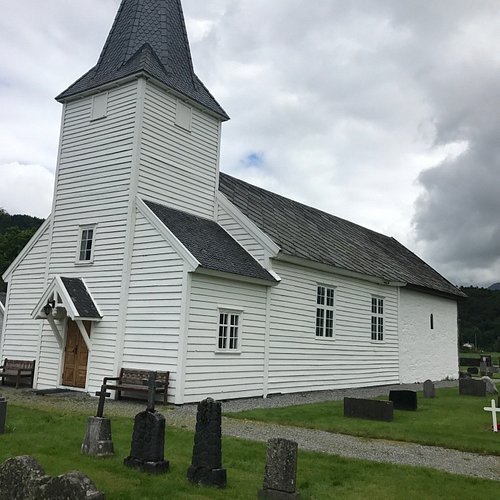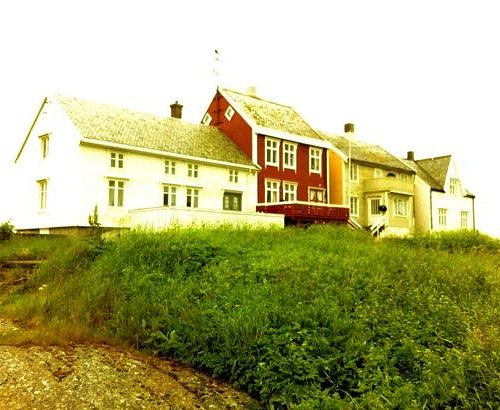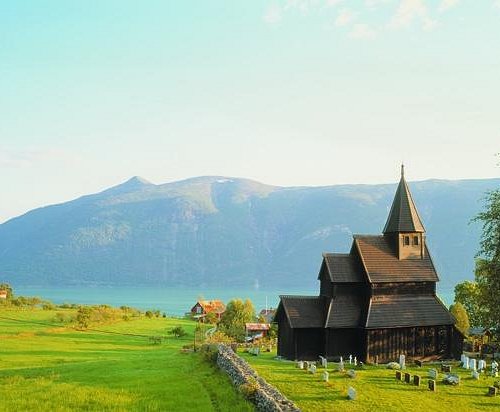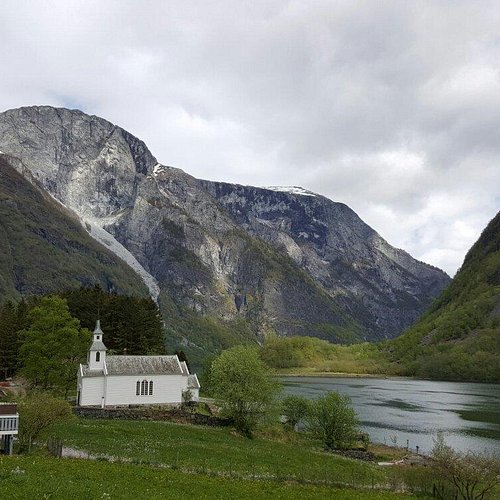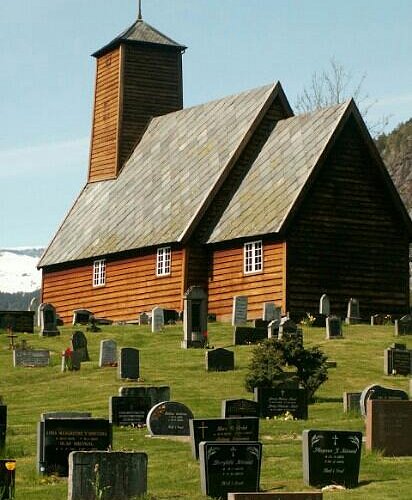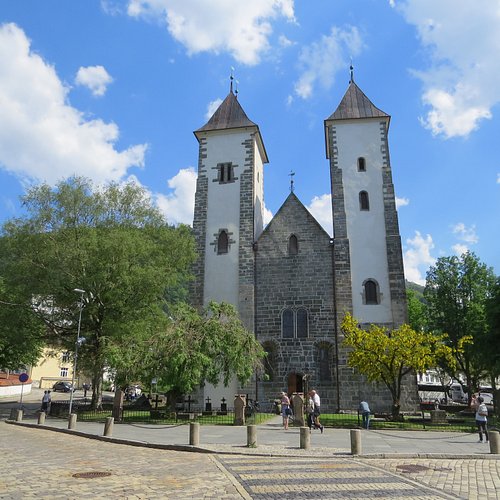Things to do in Fjord Norway, Fjord Norway: The Best Churches & Cathedrals
Discover the best top things to do in Fjord Norway, Norway including Liabygda Church, Stodle Church, Grip Stave Church, Urnes Stave Church, Bakka Church, Borgund Church, Gaupne Old Church, Halsnoy Abbey, St. Olav's Church, St. Mary's Church.
Restaurants in Fjord Norway
1. Liabygda Church
Overall Ratings
5.0 based on 2 reviews
Liabygda Church is a wooden, single-nave church, constructed in 1917, seating 165. The architect was Henry Bucher, Oslo, and the builder was Tore Overa. Student of Theology Lars Lied was actively engaged in decorating the church, with chandeliers from Paris and Berlin and lamps from Lyon and Brussels. The interior and the canopy altar had an eastern influence. The church was restored in 1989-90, and amongst other new features was an extension at the main entrance (in part across the full width if the nave) for toilets and a new stairway to the spire, bier room and washroom for in the cellar for the gravediggers. The architect was Spjelkavik Architect Office. (Source: Kyrkjene i More, Kulturnett).
2. Stodle Church
Overall Ratings
5.0 based on 3 reviews
In Stodle, as at Grindheim, we are able to observe the connection between the church, cemetery and a pre-Christian burial ground. The long church was the Viking chieftain Erling Skakke's private chapel from about 1160. The stone section was built in Romanesque style, and the timbered nave was extended around 1650. An altarpiece and a crucifix from 1636 can also be found here. The baroque pulpit dates from about 1600 and the two church bells from the Middle Ages. In front of the church is a burial mound and stone monument. On the edge of the large Stodle terrace, with its magnificent view over Etne parish and the fjord, about 15 burial mounds remain today. These were erected for the people of Stodle farm, and excavated finds bear witness to continuous habitation from the Bronze Age to the Viking Age, a period lasting some 2000 years. Helgaberget (Holy Rock) at Stodle is covered with rock carvings. Information board. Ample parking. Open Sundays: 19.00-13.00. For guided tours, please contact Church office, tel. 53 77 11 70.
3. Grip Stave Church
Overall Ratings
5.0 based on 49 reviews
In the middle of the island, protected by houses and on the island's highest point, you will find the little red stave church, standing as it has stood since appr year 1300. It has ever since been a meeting point in happy times and also in sad times. The altarpiece was donated by the Netherlands princess Elisabeth in gratitude for her rescue at sea by Norwegian sailors during a violent storm in 1515. The wall paintings date back to appr 1620.
4. Urnes Stave Church
Overall Ratings
4.5 based on 165 reviews
Norway's oldest stave church (1130) and part of UNESCO's world heritage list since 1979. We are open from 2nd May to 30th September every year (exept 17th May, which is the Norwegian Constitution Day).
Reviewed By traveltheworld012 - Rochester, United States
Urnes is possibly the oldest and most outstanding representative of the stave churches. The church expresses in wood how structures of Romanesque architecture were designed. By the use of cylindrical columns with cubic capitals and semi-circular arches. The wood carving and sculpted decor of excellent quality on the outside includes strap-work panels and elements of Viking tradition from the 11th century which constitute the origin of the "Urnes style” also found in other parts of Scandinavia and North-Western Europe. The carvings on the northern wall are a decoration of interlaced, fighting animals. Similar carvings cover the western gable triangle of the nave and the eastern gable of the choir. The carvings are important both as outstanding artistic artifacts, and as a link between the pre-Christian Nordic culture and the Christianity of the medieval ages. Many of the Viking styled carvings originated from the the Celts in Ireland. The Urnes Stave Church has been sort of renovated over the centuries where they cut and repaired portions of the interior. One of the large main columns inside had been cut off to create a private area for the pastor. The result was that the church started to lean a bit. They then had to add squared timbers inside to stabilize the structure but it still leans a bit. It is well worthwhile to take the tour which allows you to go inside as well as learning about the transitions and changes made and the meanings of the carvings. To get to this church requires greater effort as it is not just on the side of a highway like many other stave churches. One could certainly drive from Skjolden the 30+ km but beware it is a rough road. The alternative is to go to Solvorn and take the ferry across to Ornes, then walk up the hill maybe 3/4 mile to the church. I do not advise taking a car on the ferry if you are just going to visit the church. Parking is limited at Ornes and you will have to walk a portion of it anyway. All vehicles have to be backed onto the ferry and it only holds eight. There is also a visitor center across from the church with a gift shop and more historical exhibits.
5. Bakka Church
6. Borgund Church
Overall Ratings
4.5 based on 21 reviews
Borgund Church is situated in the old trading community Borgundkaupangen, and is partially built on the remains of the old St. Peter's Church from the 12th century. Most parts of today's church are from 1904, with lovely carvings by Nicolai Mejdel og Hans Johannessen. Borgund Church can seat 650 people. The church was reconstructed after a fire in 1904, but they chose to keep the roman style. Parts of the church originate from the St. Peter's Church, which was built in the 12th century. There was several extentions made between 1632 -1868. Notice the beautiful carved interior, made by Nicolai Mejdel and HansJohannessen, Lars Kinsarvik, Lerdal, Johansen and Johannes Rykken. Study the stone altar from the Middle Ages. During the Middle Ages, the trading community in Borgundkaupangen had three churches, and hidden under the ground on the way to Borgund Animal Club, lies the remains of a marble church, Kirstkyrkja. This has probably been a cathedral. Several burial mounds from the Middle Ages have also been discovered in the area around Katevagen. When arranged visits at Borgund church are requested, please contact the church office in advance to make an appointment. This in order to avoid funerals, weddings etc.
7. Gaupne Old Church
Overall Ratings
4.5 based on 8 reviews
The old church of Gaupne is a beautiful example of old Lutheran style with its ornamented bench sides, tendril paintings on the walls, catechism tablet from 1589 and pulpit.
8. Halsnoy Abbey
Overall Ratings
4.5 based on 7 reviews
A medieval Monastery in beautiful surroundings. Guided tours are given in norwegian and english upon request. Inside the main building there is a small cafe where you can buy cakes, coffee and various pastries.
9. St. Olav's Church
Overall Ratings
4.5 based on 133 reviews
Reviewed By Maui2010_10
We attended one of the Sunday morning communion services here during our stay in Balestrand. It was such a joy to get to worship in this historic building. A wonderful experience.
10. St. Mary's Church
Overall Ratings
4.0 based on 334 reviews
This early 12-century church is a wonderful example of Romanesque architecture.
Reviewed By Aussie252 - Perth, Australia
Adjacent to Schotstuene (part of Hanseatic musem), this church was linked to the Hanseatic League. Gorgeous church to view inside and out. A must if you are interested in the history of Bergen.

